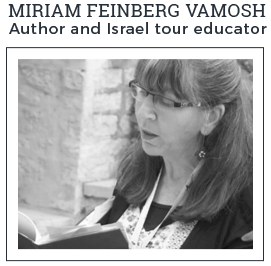It’s About Then, it’s About Now, it’s About Time
It’s About Then, it’s About Now, it’s About Time
Disaster, success, gleaning, growing
How will this turn out? Will some cataclysmic event occur while it’s underway? What will it mean for our future? Those are the questions we’ve been asking ourselves these days, that’s for sure, but no, they have nothing to do with the recent presidential visit. They are the same questions people have been asking themselves at this season in this part of the world (and not only) for thousands of years. The season? Between Passover and Pentecost, the time of the Counting of the Omer. Omer is the Hebrew word for a measure of grain – equal to about six gallons. In the Holy Land spring, barley and wheat are harvested in the season between Passover and Pentecost. The counting took place over seven weeks, 49 days (Pentecost means “weeks” in Greek).

A grain field at harvest time, near the Yarkon Springs, Israel. Photo: Miriam Feinberg Vamosh
Hope, anticipation, almost unbearable tension, dread – sound familiar? We all experience them, but they were hallmarks of this season in that biblical counting of the passing days. In later times, mourning rituals became associated with this period, although no one can say for certain why . Nogah Hareuveni, founder of Neot Kedumim Biblical Landscape Reserve, wrote that it was because the weather in the Holy Land is very capricious around now. With everything from the “latter rains” to hail storms and heat waves, these 49 days of the Omer were “ripe” with potential for either disaster or success of the harvest, putting people into a very somber state of mind. That’s why the Bible commands sacrificing part of a successful harvest in thanksgiving.

Granddaughter Eliah, all decked out with her basket of fruits to take to pre-school to celebrate Shavuot/Pentecost. Photo: Maya Dubinsky
According to a fifteenth-century scholar, Rabbi Yitzhak Arama, Psalm 67, which in Hebrew is said to have 49 words – one for each day of the counting – should be recited each day of the Omer. Have a look at this beautiful piece of Hebrew poetry and notice the universalist sentiment it shares.
And speaking of sharing, like Passover, Pentecost is a holiday Judaism and Christianity share – according to Acts 2, the Holy Spirit descended on a group of Jerusalemites from all over the world during this very festival. If you study more about Pentecost/Shavuot in the Hebrew Scriptures, you will doing one of my favorite things: focusing on what unites us instead of what divides us.

Enlargements of Israeli children’s drawings on the walls of Dizengoff Center in Tel Aviv, under the motto: “Embracing our Differences.” Psalm 67 tells us that whatever our differences, we’re all in this together. Photo: Miriam Feinberg Vamosh
Eventually, Jews began associating the Feast of Weeks with the giving of the Ten Commandments on Mt. Sinai, based on the opening verse of Exodus 19, where the words “that same day” seem to mean the “festival of the giving of the Torah” and the Feast of Weeks/Shavuot/Pentecost coincided on the calendar.
Ruth
On Shavuot, we read the Book of Ruth in synagogue. Why? One tradition says Ruth and Naomi came from Moab to Bethlehem around this time of year, and Ruth’s accepting the Israelites as her own people recalls the Israelites’ acceptance of the Torah at Mt. Sinai.
The story of Ruth is, among many things, the saga of a widow – one of the most disenfranchised and at-risk members of biblical society – who leaves home and everything familiar, accompanies her mother-in-law Naomi all the way through the burning desert (a feat in itself, and not only because of the weather…) from Moab east of the Jordan to Naomi’s home in Bethlehem, to embark on a new life. It is Ruth’s courage and conviction that propel her forward through history, an example to us down to this very day: She is the ancestress of King David (who, tradition says, died on Shavuot) and as such, earns her place in the genealogy of Jesus (Matt. 1:5).
And as we read of Ruth gleaning in the fields of Boaz, we learn how Boaz obeyed the biblical injunction to leave the corners of his field unshorn so the poor could take this part of the harvest home (Lev. 23:22). “Why are you so kind to me, to single me out, when I am a foreigner?” (Ruth 2:10), Ruth asks Boaz. In expounding on the connection between this story and Leviticus 23:22, Prof. Judith A. Kates says in the wonderful book Reading Ruth: “Ruth is relying on one of the fundamental principles of Torah law…Leviticus makes it clear that we should understand this obligation as a mode of connection to God…acknowledging that what we have is ultimately a gift to be shared.”
Don’t you agree?
Happy Shavuot/Happy Pentecost!
Recommended Reading
Miriam Feinberg Vamosh, Food at the Time of the Bible: From Adam’s Apple to the Last Supper (Herzliya, Israel: Palphot, n.d.)
Nogah Hareuveni, Nature in our Biblical Heritage (Kiryat Ono, Israel: Neot Kedumim, 1980)
Judith A. Kates and Gail Twersky Reimer (eds.), Reading Ruth (New York: Ballantine Books, 1994)








Beautifully written, perfectly explained, interesting, I could not stop reading until the end and wanted more! I loved the picture of Eliah in her Shavuot clothes and the pictures of the children with the motto”Embracing our differences”